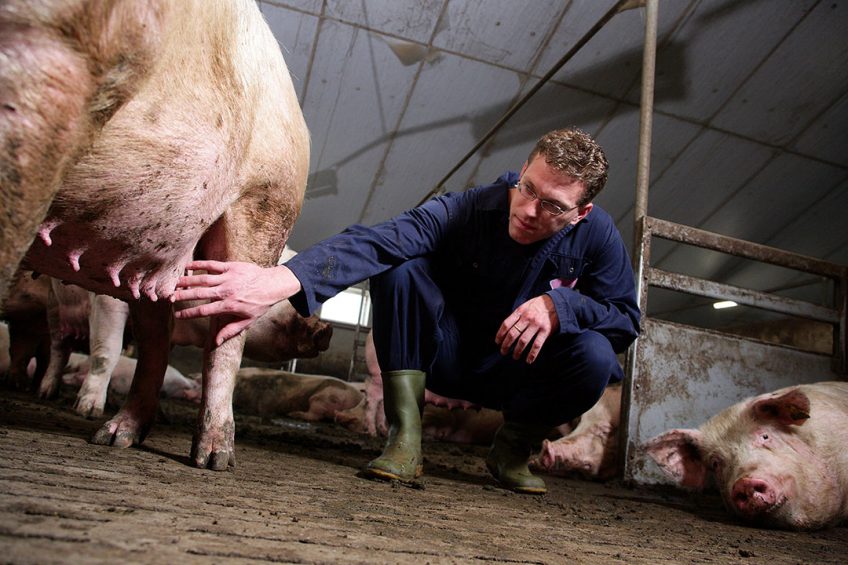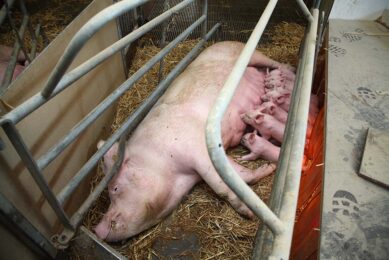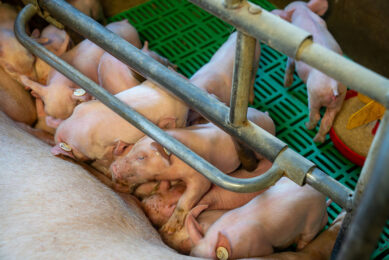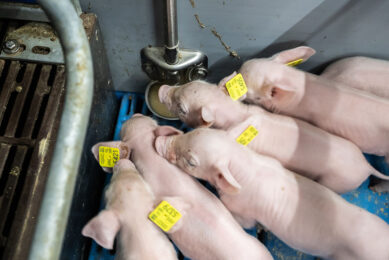Gestating sows hold key to piglet quality

Piglet quality is getting more attention due to the continuous improvement in litter sizes. But, starting measuring piglets intensively after birth might not be the best solution for piglet quality improvement. Birth weight of piglets, determined during gestation, is of tremendous importance for piglet survival and early development. Influencing this, therefore should be a prerequisite to effectively improve piglet quality.
Piglets can be weighed and monitored routinely after birth. But the interaction between sow and piglet starts in gestation. Important traits like birth weights, early piglet survival, and piglet immunity get determined before farrowing and the largest influences might be in early gestation. Continuous monitoring of sow feed intake and weights in gestation has become a regular practice in the last decade. Group-housed sows required new technologies to provide individual attention to each of them. Irregularities and trends in feed intake get known in much more detail for specific feeds, regions, and genetics. It is a natural development that the industry starts now utilising these information sources to track the uterine and foetal development of litters. With increased prolificacy across merely all genetics, the attention for piglet quality remains a point of attention. Piglet mortality is varying between breeds, but rates of 20% pre-weaning mortality are no exception. Tackling mortality and balancing this with litter size has been challenging. Tendencies in litter size and mortality demonstrate that there is a need to improve this balance.
Reaching genetic limitations
Breeding goals remain a continuous discussion point. Short term economics might reward additional piglets, but lower piglet weights and decreased vitality require a careful determining of the desired genetic improvements. Does litter size reach a biological limit? Probably not. What will be the most limiting traits for modern pig farming? The starting point of a newborn piglet gets more and more important; vitality, birth weight, early growth, day 1-5 survival, etc. New traits that are linked to intrauterine development might be the way to start steering piglet development at an earlier phase.
Genetic companies are searching intensively for new traits that can impact the efficiency of pork production. Most genetic programmes have been focused on a very limited number of mostly traditional traits that are collected just after farrow until weaning. Piglet quality can be treated both as a piglet trait and a sow trait. Both approaches are logical. In the end, the sow determines the piglets birth weight for a large part, since the piglets rely largely on the sow during gestation. And the piglets own DNA determines its survivability and disease resistance.
There is one important factor that remains undervalued, which is the interaction between the sow and its piglets. This might change when we can use and exploit new technologies. Sensors and weighing scales can provide continuous measurements of both sow and piglets. Weight, feed intake and climate impact will be monitored continuously. Probably camera images will add another potential source of useful information at a relatively low cost in the near future. Companies are already looking at incorporating images to improve sow management or monitor production. It will be clear that this will generate information about the sow and piglet interaction and a potential source for new traits.
The piglets first recordings will no longer start at birth but can start in fact already at conception. But even traits registered before conception can have a determining influence on the piglets’ early and later development. Although during gestation it will be impossible to track individual piglet’s records, it will probably be possible to start measuring and assigning weight and feed intake measures to the litter at mid-gestation. The impact of more detailed monitoring of sows during gestation adds new opportunities. First of all, it makes it possible to steer maternal sow efficiency in much more detail. The full efficiency of sows to convert feed into pork will be complete at last. Differences in annual feed consumption of sows will be judged against its piglet and milk production. This might be the missing link to reach full stable efficiency.
Tailor-made diets
Individual knowledge of sow requirements and feed intake also opens up opportunities to individual sow feeding. Instead of grouping sows and assigning them at the start of gestation to a predefined group with a fixed feed curve, the development of both sows and piglet litters can be fine-tuned more intensively. This will enable us to learn what the optimum weight curves are for sows of certain genetics and parity. Also, this will provide more knowledge for steering towards an optimum sow weight and piglet birth weight. In addition, this will be the base for more detailed knowledge about the requirements for both sow and piglets, adjusted for their specific circumstances.
This will create new sow efficiency parameters that can be used to create the ideal future sow. Most prolific, most economic or most sustainable. A sow that combines low maintenance with excellent milk production and sustainable production. A sow that directly optimises the efficiency of pork production under practical farming conditions. Knowing the requirements of the sows and piglets in more detail by getting daily actualised measurements makes it possible to steer sows and piglets in a much more advanced way. Daily steering of pigs and sows is within reach. Actual status and behaviour of the pig will determine the mix of feed it receives at the moment it gets to the feed trough. In today’s practice, genetic companies try to make the best average parent stock sow and nutritionists try to steer this model-sow the best during its life cycle stages. Steering this sow on average groupings has been common practice and was quite successful, but farmers still struggle with lack of uniformity in the sows and piglets. Knowing the optimum development track of both sows and piglets in more detail and getting daily actualised measurements provides opportunities for much more detailed steering. When a sow has not eaten sufficiently, feed quantities and composition can be adjusted the same day.
The pork industry is at the edge of a new era. An era where animals and devices are connected. Information can be monitored and stored for analysis. It is up to genetic companies to derive new trials out of this and link this with the optimum genetic DNA profiles of future sows and piglets.
 Beheer
Beheer




 WP Admin
WP Admin  Bewerk bericht
Bewerk bericht